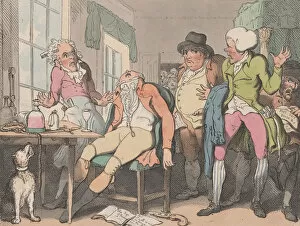Overdose Collection
"Exploring the Tragic Consequences: Overdose in Art and Society" In the world of art, various mediums have been used to depict the harrowing concept throughout history
All Professionally Made to Order for Quick Shipping
"Exploring the Tragic Consequences: Overdose in Art and Society" In the world of art, various mediums have been used to depict the harrowing concept throughout history. From William Hogarth's iconic engraving "Marriage a la Mode, Plate VI, The Ladys Death" in 1745 to his oil painting "Marriage a la Mode: VI, The Ladys Death" around 1743, these masterpieces capture the devastating consequences of excessive indulgence. Moving forward in time, Thomas Rowlandson's satirical piece titled "School for Modern Romans" from May 10th, 1802 humorously highlights society's fascination with drugs and their potential dangers. Richard James Lane's portrait of Isabella Anson in 1840 serves as a reminder that even high society was not immune to the perils associated with substance abuse. Fast-forwarding into the modern era, we encounter comic postcards depicting doctor-patient interactions and conceptual images symbolizing overdose. These contemporary artworks shed light on our ongoing struggle with addiction and its impact on individuals' lives. Furthermore, conceptual artwork like "Psychiatric drugs F006/8821, " "Drugs F006/8822, " and "Pills F006/8783" emphasize society's reliance on medication while raising questions about responsible usage. Meanwhile, an image portraying a spoonful of medicine (F006/9045) reminds us that even well-intentioned treatments can lead to unintended consequences if misused or abused. Through these diverse artistic representations spanning centuries, we are confronted with the stark reality surrounding overdose – an issue deeply intertwined with human existence. It prompts us to reflect upon our own relationship with substances and encourages conversations about prevention strategies and support systems for those affected by addiction. Ultimately, these artworks serve as powerful reminders that overdose is not merely confined within canvas frames; it permeates our daily lives as a societal concern that demands attention, understanding, and compassion.














